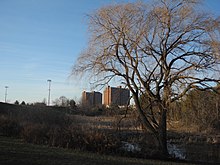
A pocket forest is created by planting native trees and shrubs in close proximity as a means of rapidly restoring native plant species in damaged ecosystems. While forests naturally grow through a primary stage and then a secondary stage before reaching their climax stage, pocket forests are created by a dense planting of climax stage species which grow rapidly in competition for sunlight.
Pocket forests have been embraced by environmentalists as a means of reforesting urban spaces and teaching urban residents about native forest environments. The growing interest in pocket forests was inspired in large part by the work of Japanese botanist Akira Miyawaki, whose "Miyawaki forests" have influenced the development of a variety of pocket forest methodologies adapted to different climates and spacial constraints.
Methods

A variety of protocols for site preparation and planting have been developed, all sharing the same underlying principles as the Miyawaki method. The following is an example methodology:
The area to be planted is first covered with a layer of cardboard which is then covered with 3–6 in (7.6–15.2 cm) of compost and allowed to acclimate to local moisture conditions for several months. The covered area is then planted with year-old plant nursery saplings spaced approximately 2 ft (0.6 m) apart. The entire surface area should be planted at the same time with a variety of native species so no saplings of the same species are adjacent to each other. Watering is unnecessary for native plants acclimated to the local environment; although watering for the first few years after planting, and during drought periods, will reduce mortality of individual plants. Pocket forests planted with greater density than commercial timberland utilize edge lighting in addition to overhead lighting to grow faster while absorbing more carbon dioxide per acre.
Three is the minimum number of different species of nursery saplings for planting a pocket forest. The arrangement below of species A, B and C illustrates avoidance of planting the same species in adjacent positions.
A B C A B C A B C A B C A
Examples
- Pocket Forests CLG assists creation of pocket forests of 6–50 m (65–538 sq ft) within urban areas of Ireland.
- The Yakama Nation has planted seven pocket forests of 47 species totaling 23,000 sq ft (2,100 m) on their corrections and rehabilitation facility.
- A Miyawaki forest has been planted over a landfill in Cambridge, Massachusetts, as part of Danehy Park.
- A 1,000 sq ft (93 m) forest has been planted as part of Griffith Park in Los Angeles.
- Several Miyawaki forests have been planted in Berkeley, California.
- A 770 m (8,300 sq ft) pocket forest of 20 species is being planted in the City of Brussels.
- The town of Ayer, Massachusetts, organized community volunteers to plant a pocket forest.
Potential problems

Miyawaki developed the method as a means of replenishing forest soils by allowing dead leaves and twigs to decompose in a moist, wood-rotting ecosystem. This process may be less successful in drier fire ecosystems where nutrients are recycled as ashes. The dense pocket forest forms a capture mechanism for wind-blown embers, dried ground litter is an ignition source, and the multi-layered pocket forest forms a fuel ladder with wildfire risks in urban areas.
Image Gallery
-
 Miyawaki forest at Edappally, Eranakulam
Miyawaki forest at Edappally, Eranakulam
-

-

-

References
- ^ Hahn, Sophie. "Budget Referral: Miyawaki "Pocket Forest" Pilot Program to Support Carbon Sequestration, Biodiversity, Cooling, Noise Reduction, Health, and Equity" (PDF). Berkeley, California. Retrieved 1 October 2023.
- "Strength in Numbers: The Basics of a Pocket Forest". Leaf & Limb. Retrieved 1 October 2023.
- "Pocket forests: A growing idea finds a home in urban settings". Ferns & Feathers. Retrieved 1 October 2023.
- "Pocket Forests". The Digital Hub. Retrieved 1 October 2023.
- Bryson, Ethan. "Healing Forest". SUGi. Retrieved 1 October 2023.
- ^ Buckley, Cara (24 August 2023). "Tiny Forests with Big Benefits". The New York Times. Retrieved 1 October 2023.
- de Brabandère, Nicolas. "Tour & Taxis Forest". SUGi. Retrieved 1 October 2023.
- Manoian, Alan S. "Pocket Forest Planting Day". Ayer, Massachusetts. Retrieved 1 October 2023.
- "2,200 trees planted in Changunarayan forest". Himalayan News Service. 16 July 2017. Retrieved 2 October 2023.
- Kloetzli, Sophie. "Des forêts en ville? La méthode Miyawaki n'est pas la solution miracle". reporterre.net. Retrieved 3 October 2023.
- "Restoring Mediterranean forests with the Miyawaki method" (PDF). DG Environment News Alert Service. European Union. 14 April 2011. Archived from the original (PDF) on 2012-05-11. Retrieved 3 October 2023.
- Loudermilk, E. Louise; O'Brien, Joseph J.; Goodrick, Scott L.; Linn, Rodman R.; Skowronski, Nicholas S.; Hiers, J. Kevin (2022). "Vegetation's influence on fire behavior goes beyond just being fuel". Fire Ecology. 18 (1). Springer Open: 9. Bibcode:2022FiEco..18a...9L. doi:10.1186/s42408-022-00132-9.
Further reading
- Buckley, Cara (24 August 2023). "Tiny Forests With Big Benefits". The New York Times. Retrieved 4 March 2024.
- Zeldovich, Lina (24 July 2019). "The Miyawaki Method: A Better Way to Build Forests?". JSTOR Daily. Retrieved 4 March 2024.